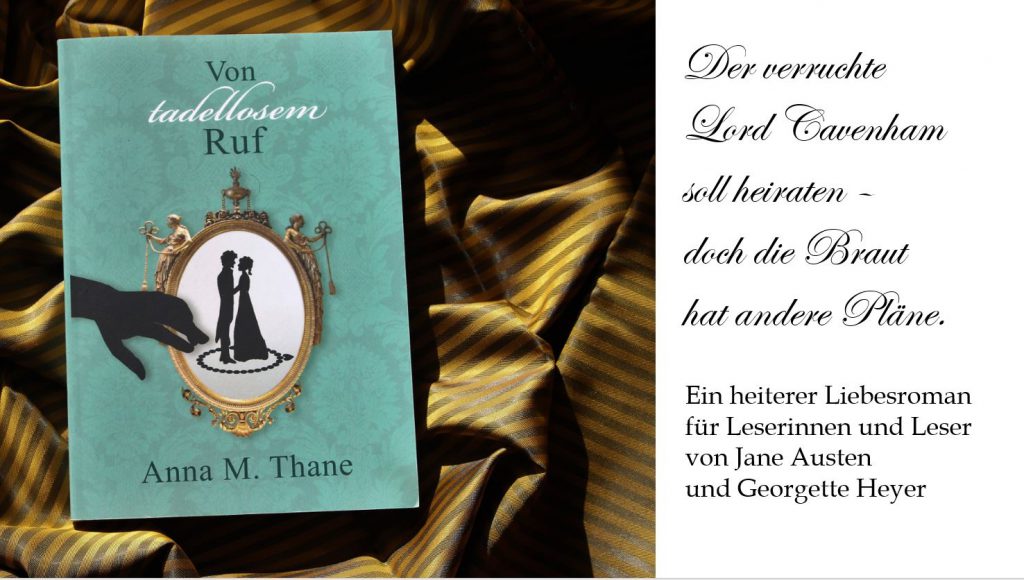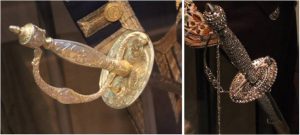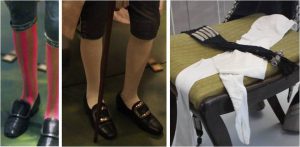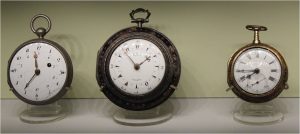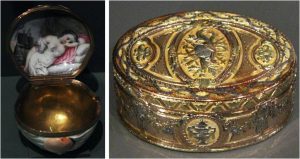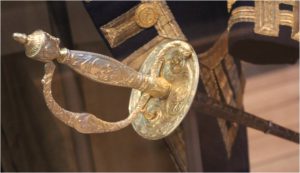 Court suits, breeches and waistcoats of the 18th century are highly aesthetic. They are, however, incomplete without the matching accessories. Therefore, stockings, dress swords, watches, buttons, etc. are in the spotlight of today’s post. I have compiled a selection of photos of these beautiful fashion items, so follow me to the world of accessories for gentlemen.
Court suits, breeches and waistcoats of the 18th century are highly aesthetic. They are, however, incomplete without the matching accessories. Therefore, stockings, dress swords, watches, buttons, etc. are in the spotlight of today’s post. I have compiled a selection of photos of these beautiful fashion items, so follow me to the world of accessories for gentlemen.
Dress swords
The sword, once a weapon, became a fashion item in the late 18th century. As dress sword, it was a standard accessory for gentlemen, but wouldn’t be worn when dancing. Dress swords were explicitly forbidden at Almack’s. Gentlemen were required to leave their swords at the door.
The dress sword on the left (photo below) is from an admiral’s full-dress uniform. It is a small-sword and was worn at formal events. The right one is a civilian dress sword from about 1780 – 1790. It is especially glamorous as the hilt is made of cut-steel studs that sparkle in candle light.
(Click on the photos to enlarge them.)
Stockings
Stockings are indispensible in an age where knee-length breeches were predominant. Men of fashion of the 1750ies wore colourful stockings with stripes, e.g. in pink and buff (see photo below, left side). White stockings were generally very popular and would do for all occasions.
Silk stockings should be worn by men when attending a ball. The ones on the photo (right side) completed a hussar uniform around 1815. You can well image a soldier wearing them to the Duchess of Richmond’s ball in Brussels at the eve of the battle of Waterloo.
(Click on the photos to enlarge them.)
Buttons
Buttons were a fashion statement, saying “look at me”, “I am rich” or “I have taste”. The best buttons were made in Birmingham, and the Prince of Wales preferred to wear these.
Buttons were made of metal or pearl. Brass buttons were for military uniforms, plain metal ones for everyday wear. Cut steel buttons (see photo in the middle) or pearl buttons were for the fashionable and rich. Around 1800, Matthew Boulton produced cut steel buttons, crammed with polished tiny steel studs. In candlelight, the buttons would sparkle like diamonds. They were for men only and worn at court.
(Click on the photos to enlarge them.)
Buckles
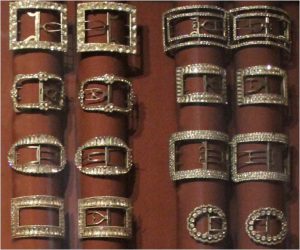 Shoe buckles were made of pewter, brass, bronze or silver. When decorating jewels were applied, these usually were simple paste jewels. During the 18th century, shoe buckles for men got bigger, the largest being about 6 x 9 cm. It was again at Birmingham, the centre of metal work, where the best shoe buckles were produced.
Shoe buckles were made of pewter, brass, bronze or silver. When decorating jewels were applied, these usually were simple paste jewels. During the 18th century, shoe buckles for men got bigger, the largest being about 6 x 9 cm. It was again at Birmingham, the centre of metal work, where the best shoe buckles were produced.
Watches
Pocket watches were luxury items and status symbols. They were carried around in small watch pockets in breeches. Another option was to attach a watch to a fob. On the photo below you can see watches made in France and England. The French one on the left is a rare decimal dial watch. It was made around 1795 – 1800, when Napoleonic France introduced decimal time. The watch features ten 100-minute hours.
(Click on the photos to enlarge them.)
Snuff boxes
Snuff is a pulverized form of tobacco that was inhaled through the nostril from about the early seventeenth century. Snuff was often kept in snuff boxes, but could also be kept in a jar. Some people even carried it loosely in their pocket.
The snuff box with its decorative elements became quickly fashionable – it was, of course, another chance to display one’s taste and wealth. Size and shape varied, though the oval shape and a size about 3 -4 inches were rather popular.
Ornaments and illustration included encrusted jewels and enamelling. The snuff box on the left (see photo below) features a slightly erotic painting of a sleeping beauty, her bosom partly revealed. The box was made around 1745. The snuff box on the right side celebrates science and a balloon ascent. It’s from 1783-1785.
(Click on the photos to enlarge them.)
Walking sticks
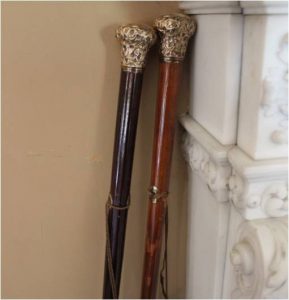 Walking sticks – or canes – served as a substitute for swords, symbolising power, authority and social prestige. However, they could be used in combat if necessary, which probably came in handy during the mid-18th century, when robbers and thieves rendered the streets of London unsafe. 18th-century canes were longer than the ones we know today (think about symbolism), they might reach to the lower rib. Styles varied from rather simple wood canes for middle class-men to elaborate and stylish ones for the rich. Men of fashion would fix ribbons to their cane.
Walking sticks – or canes – served as a substitute for swords, symbolising power, authority and social prestige. However, they could be used in combat if necessary, which probably came in handy during the mid-18th century, when robbers and thieves rendered the streets of London unsafe. 18th-century canes were longer than the ones we know today (think about symbolism), they might reach to the lower rib. Styles varied from rather simple wood canes for middle class-men to elaborate and stylish ones for the rich. Men of fashion would fix ribbons to their cane.
Jabots
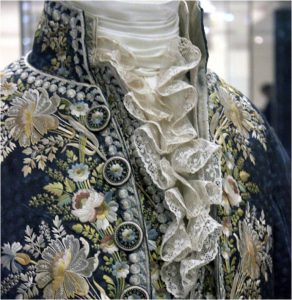 Please try to focus on the lace, however tempting the embroidered buttons of the court suit on the photo are. A jabot added a sophisticated touch to a man’s outfit. It was usually made of white linen or cotton and trimmed with rich lace. It was tied loosely around the neck, and the lace fell decoratively in the opening of the waistcoat or suit coat. By the end of the 18th century, the jabot was replaced by a simpler neck cloth. Wearing a jabot with lace was limited for very formal occasions e.g. court ceremonies.
Please try to focus on the lace, however tempting the embroidered buttons of the court suit on the photo are. A jabot added a sophisticated touch to a man’s outfit. It was usually made of white linen or cotton and trimmed with rich lace. It was tied loosely around the neck, and the lace fell decoratively in the opening of the waistcoat or suit coat. By the end of the 18th century, the jabot was replaced by a simpler neck cloth. Wearing a jabot with lace was limited for very formal occasions e.g. court ceremonies.
Related posts
- The Evolution of the Waistcoat in the 18th Century
- The Unrivalled Beauty of the Hand-held Fan in the Romantic Age
- Fashion Meets Scientific Progress: The “Spy Fan”
- Fabulous Fashion Item: A Brief History of the Hand-held Fan
- A Brief History of the Napoleonic Wars told … in 10 Hand-held Fans
Sources
V & A Museum, Cromwell Rd, London SW7 2RL, UK
National Maritime Museum, Park Row, Greenwich, London SE10 9NF, UK
Birmingham Museum and Art Gallery, Chamberlain Square, Birmingham B3 3D, UK
Fan Museum, 12 Crooms Hill, London SE10 8ER, UK
Kenwood House, Hampstead Ln, Hampstead NW3 7JR, UK
Royal Greenwich Observatory, Blackheath Ave, London SE10 8XJ
http://www.fashionencyclopedia.com/fashion_costume_culture/European-Culture-18th-Century/index.html
http://www.marquise.de/en/1700/howto/18accessoires.shtml
Article by Anna M. Thane, author of the novel
“Von tadellosem Ruf” (http://amzn.to/2TXvrez)
